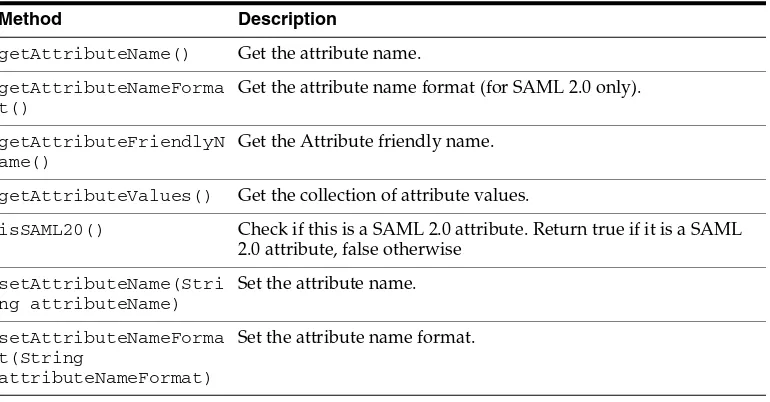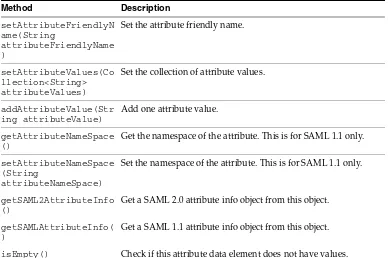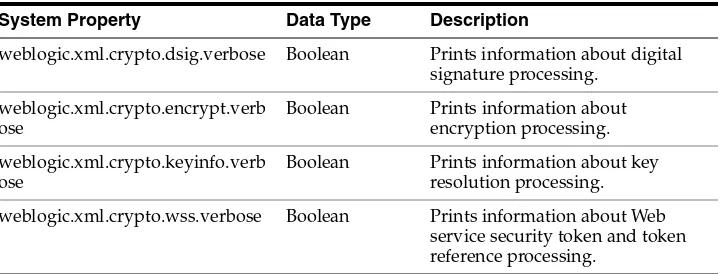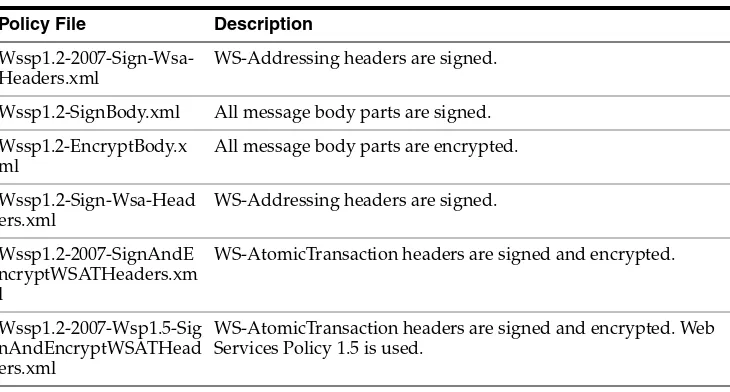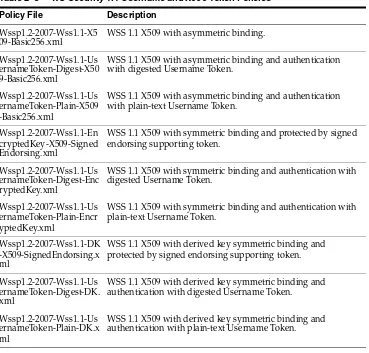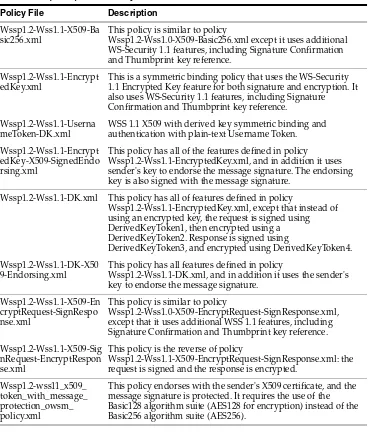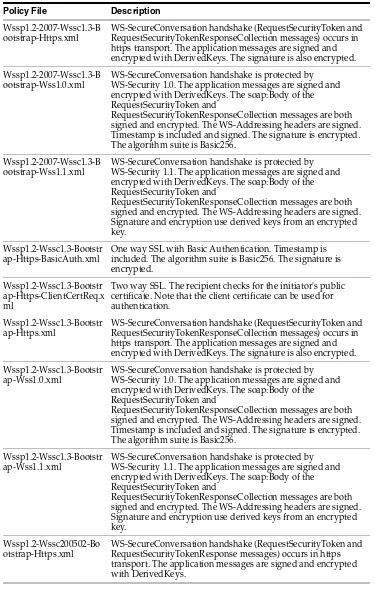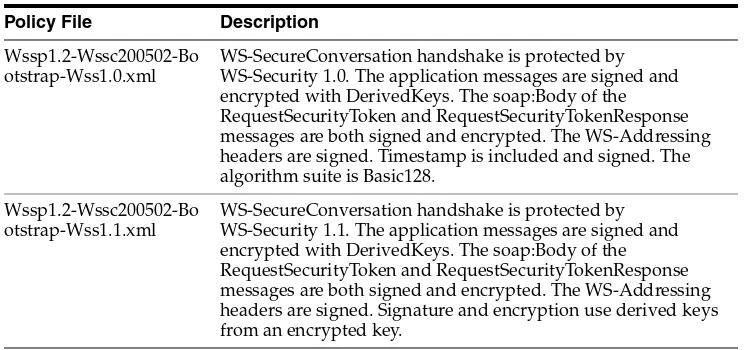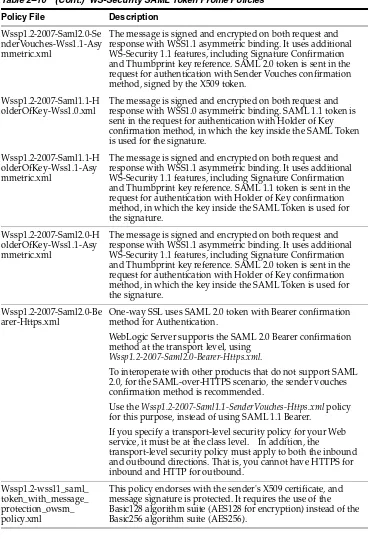11
g
Release 1 (10.3.5)
E13713-05April 2011
E13713-05
Copyright © 2007, 2011, Oracle and/or its affiliates. All rights reserved.
This software and related documentation are provided under a license agreement containing restrictions on use and disclosure and are protected by intellectual property laws. Except as expressly permitted in your license agreement or allowed by law, you may not use, copy, reproduce, translate, broadcast, modify, license, transmit, distribute, exhibit, perform, publish, or display any part, in any form, or by any means. Reverse engineering, disassembly, or decompilation of this software, unless required by law for interoperability, is prohibited.
The information contained herein is subject to change without notice and is not warranted to be error-free. If you find any errors, please report them to us in writing.
If this software or related documentation is delivered to the U.S. Government or anyone licensing it on behalf of the U.S. Government, the following notice is applicable:
U.S. GOVERNMENT RIGHTS Programs, software, databases, and related documentation and technical data delivered to U.S. Government customers are "commercial computer software" or "commercial technical data" pursuant to the applicable Federal Acquisition Regulation and agency-specific supplemental regulations. As such, the use, duplication, disclosure, modification, and adaptation shall be subject to the restrictions and license terms set forth in the applicable Government contract, and, to the extent applicable by the terms of the Government contract, the additional rights set forth in FAR 52.227-19, Commercial Computer Software License (December 2007). Oracle USA, Inc., 500 Oracle Parkway, Redwood City, CA 94065.
This software is developed for general use in a variety of information management applications. It is not developed or intended for use in any inherently dangerous applications, including applications which may create a risk of personal injury. If you use this software in dangerous applications, then you shall be responsible to take all appropriate fail-safe, backup, redundancy, and other measures to ensure the safe use of this software. Oracle Corporation and its affiliates disclaim any liability for any damages caused by use of this software in dangerous applications.
Oracle is a registered trademark of Oracle Corporation and/or its affiliates. Other names may be trademarks of their respective owners.
Preface
... viiDocumentation Accessibility ... vii Conventions ... vii
1
Overview of Web Services Security
1.1 Overview of Web Services Security ... 1-1 1.2 What Type of Security Should You Configure? ... 1-1
2
Configuring Message-Level Security
2.8.2.3 Configuring STS URI for SAML: Standalone Client ... 2-30 2.8.2.4 Configuring STS URI Using WLST: Client On Server Side... 2-30 2.8.2.5 Configuring STS URI Using Console: Client On Server Side... 2-31 2.8.2.6 Configuring STS Security Policy: Standalone Client... 2-31 2.8.2.7 Configuring STS Security Policy Using WLST: Client On Server Side... 2-32 2.8.2.8 Configuring STS Security Policy: Using the Console... 2-32 2.8.2.9 Configuring the STS SOAP and WS-Trust Version: Standalone Client ... 2-33 2.8.2.10 Configuring the SAML STS Server Certificate: Standalone Client... 2-34 2.8.3 Sample WS-Trust Client for SAML 2.0 Bearer Token Over HTTPS... 2-34 2.8.4 Sample WS-Trust Client for SAML 2.0 Bearer Token with WSS 1.1 Message
2.21.1 Example of Security Policy With Policy Alternatives ... 2-87 2.21.2 Configuring Smart Policy Selection ... 2-89 2.21.2.1 How the Policy Preference is Determined ... 2-90 2.21.2.2 Configuring Smart Policy Selection in the Console... 2-90 2.21.2.3 Understanding Body Encryption in Smart Policy ... 2-90 2.21.2.4 Smart Policy Selection for a Standalone Client ... 2-91 2.21.3 Multiple Transport Assertions... 2-92 2.22 Example of Adding Security to MTOM Web Service... 2-92 2.22.1 Files Used by This Example ... 2-92 2.22.2 SecurityMtomService.java ... 2-93 2.22.3 MtomClient.java... 2-95 2.22.4 configWss.py Script File ... 2-98 2.22.5 Build.xml File ... 2-100 2.22.6 Building and Running the Example... 2-103 2.22.7 Deployed WSDL for SecurityMtomService ... 2-104 2.23 Example of Adding Security to Reliable Messaging Web Service... 2-108 2.23.1 Overview of Secure and Reliable SOAP Messaging... 2-108 2.23.2 Overview of the Example ... 2-109 2.23.2.1 How the Example Sets Up WebLogic Security ... 2-109 2.23.3 Files Used by This Example ... 2-110 2.23.4 Revised ReliableEchoServiceImpl.java ... 2-111 2.23.5 Revised configWss.py ... 2-111 2.23.6 Revised configWss_Service.py ... 2-112 2.23.7 Building and Running the Example... 2-113 2.24 Securing Web Services Atomic Transactions... 2-113 2.25 Proprietary Web Services Security Policy Files (JAX-RPC Only) ... 2-115 2.25.1 Abstract and Concrete Policy Files... 2-116 2.25.2 Auth.xml ... 2-116 2.25.3 Sign.xml... 2-117 2.25.4 Encrypt.xml ... 2-118 2.25.5 Wssc-dk.xml ... 2-119 2.25.6 Wssc-sct.xml ... 2-120
3
Configuring Transport-Level Security
3.1 Configuring Transport-Level Security Through Policy ... 3-1 3.1.1 Configuring Transport-Level Security Through Policy: Main Steps ... 3-2 3.2 Example of Using JWS Annotations in Your JWS File ... 3-3 3.3 Example of Configuring Transport Security for JAX-WS ... 3-3 3.3.1 One-Way SSL (HTTPS and HTTP Basic Authentication Example)... 3-4 3.4 New Two-Way Persistent SSL Client API for JAX-WS ... 3-8 3.4.1 Example of Getting SSLSocketFactory From System Properties ... 3-9 3.5 Configuring Transport-Level Security Via UserDataConstraint: Main Steps
4.1 Configuring Access Control Security: Main Steps ... 4-1 4.2 Updating the JWS File With the Security-Related Annotations... 4-3 4.3 Updating the JWS File With the @RunAs Annotation ... 4-5 4.4 Setting the Username and Password When Creating the Service Object ... 4-5
A
Using Oracle Web Services Manager Security Policies
This preface describes the document accessibility features and conventions used in this guide—Securing WebLogic Web Services for Oracle WebLogic Server.
Documentation Accessibility
Our goal is to make Oracle products, services, and supporting documentation accessible to all users, including users that are disabled. To that end, our
documentation includes features that make information available to users of assistive technology. This documentation is available in HTML format, and contains markup to facilitate access by the disabled community. Accessibility standards will continue to evolve over time, and Oracle is actively engaged with other market-leading
technology vendors to address technical obstacles so that our documentation can be accessible to all of our customers. For more information, visit the Oracle Accessibility Program Web site at http://www.oracle.com/accessibility/.
Accessibility of Code Examples in Documentation
Screen readers may not always correctly read the code examples in this document. The conventions for writing code require that closing braces should appear on an
otherwise empty line; however, some screen readers may not always read a line of text that consists solely of a bracket or brace.
Accessibility of Links to External Web Sites in Documentation
This documentation may contain links to Web sites of other companies or
organizations that Oracle does not own or control. Oracle neither evaluates nor makes any representations regarding the accessibility of these Web sites.
Access to Oracle Support
Oracle customers have access to electronic support through My Oracle Support. For information, visit http://www.oracle.com/support/contact.html or visit http://www.oracle.com/accessibility/support.html if you are hearing impaired.
Conventions
The following text conventions are used in this document:
Convention Meaning
which you supply particular values.
1
1
Overview of Web Services Security
The following sections describe how to configure security for your Web service:
■ Section 1.1, "Overview of Web Services Security"
■ Section 1.2, "What Type of Security Should You Configure?"
1.1 Overview of Web Services Security
To secure your WebLogic Web service, you configure one or more of three different types of security.
1.2 What Type of Security Should You Configure?
Message-level security includes all the security benefits of SSL, but with additional flexibility and features. Message-level security is end-to-end, which means that a SOAP message is secure even when the transmission involves one or more
intermediaries. The SOAP message itself is digitally signed and encrypted, rather than just the connection. And finally, you can specify that only individual parts or elements of the message be signed, encrypted, or required.Transport-level security, however, secures only the connection itself. This means that if there is an intermediary between the client and WebLogic Server, such as a router or message queue, the intermediary gets the SOAP message in plain text. When the intermediary sends the message to a second receiver, the second receiver does not know who the original sender was. Additionally, the encryption used by SSL is "all or nothing": either the entire SOAP message is encrypted or it is not encrypted at all. There is no way to specify that only selected parts of the SOAP message be encrypted. Message-level security can also include identity tokens for authentication.
Transport-level security secures the connection between the client application and WebLogic Server with Secure Sockets Layer (SSL). SSL provides secure connections by allowing two applications connecting over a network to authenticate the other's Table 1–1 Web Services Security
Security Type Description
Message-level security Data in a SOAP message is digitally signed or encrypted. May also include identity tokens for authentication. See Chapter 2,
"Configuring Message-Level Security".
Transport-level security SSL is used to secure the connection between a client application and the Web service. See Chapter 3, "Configuring Transport-Level Security".
Access control security Specifies which roles are allowed to access Web services. See
identity and by encrypting the data exchanged between the applications.
Authentication allows a server, and optionally a client, to verify the identity of the application on the other end of a network connection. A client certificate (two-way SSL) can be used to authenticate the user.
Encryption makes data transmitted over the network intelligible only to the intended recipient.
Transport-level security includes HTTP BASIC authentication as well as SSL.
Access control security answers the question "who can do what?" First you specify the security roles that are allowed to access a Web service; a security role is a privilege granted to users or groups based on specific conditions. Then, when a client
2
2
Configuring Message-Level Security
In this release of WebLogic Server, message-level security features are supported in both the JAX-RPC and JAX-WS stacks.
The following sections describe how to configure security for your Web service:
■ Section 2.1, "Overview of Message-Level Security" ■ Section 2.2, "Main Use Cases of Message-Level Security"
■ Section 2.3, "Using Policy Files for Message-Level Security Configuration" ■ Section 2.4, "Configuring Simple Message-Level Security"
■ Section 2.5, "Updating a Client Application to Invoke a Message-Secured Web
Service"
■ Section 2.6, "Example of Adding Security to a JAX-WS Web Service" ■ Section 2.7, "Creating and Using a Custom Policy File"
■ Section 2.8, "Configuring the WS-Trust Client"
■ Section 2.9, "Configuring and Using Security Contexts and Derived Keys" ■ Section 2.10, "Associating Policy Files at Runtime Using the Administration
Console"
■ Section 2.11, "Using Security Assertion Markup Language (SAML) Tokens For
Identity"
■ Section 2.12, "Associating a Web Service with a Security Configuration Other Than
the Default"
■ Section 2.13, "Valid Class Names and Token Types for Credential Provider" ■ Section 2.14, "Using System Properties to Debug Message-Level Security" ■ Section 2.15, "Using a Client-Side Security Policy File"
■ Section 2.16, "Using WS-SecurityPolicy 1.2 Policy Files" ■ Section 2.17, "Choosing a Policy"
■ Section 2.18, "Unsupported WS-SecurityPolicy 1.2 Assertions" ■ Section 2.19, "Using the Optional Policy Assertion"
■ Section 2.20, "Configuring Element-Level Security" ■ Section 2.21, "Smart Policy Selection"
■ Section 2.21.3, "Multiple Transport Assertions"
■ Section 2.24, "Securing Web Services Atomic Transactions"
■ Section 2.25, "Proprietary Web Services Security Policy Files (JAX-RPC Only)"
2.1 Overview of Message-Level Security
Message-level security specifies whether the SOAP messages between a client application and the Web service invoked by the client should be digitally signed or encrypted, or both. It also can specify a shared security context between the Web service and client in the event that they exchange multiple SOAP messages. You can use message-level security to assure:
■ Confidentiality, by encrypting message parts ■ Integrity, by digital signatures
■ Authentication, by requiring username, X.509, or SAML tokens
See Section 2.4, "Configuring Simple Message-Level Security" for the basic steps you must perform to configure simple message-level security. This section discusses configuration of the Web services runtime environment, as well as configuration of message-level security for a particular Web service and how to code a client application to invoke the service.
You can also configure message-level security for a Web service at runtime, after a Web service has been deployed. See Section 2.10, "Associating Policy Files at Runtime Using the Administration Console" for details.
2.1.1 Web Services Security Supported Standards
WebLogic Web services implement the following OASIS Standard 1.1 Web Services Security (WS-Security 1.1 (http://www.oasis-open.org/committees/tc_ home.php?wg_abbrev=wss) specifications, dated February 1, 2006:
■ WS-Security 1.0 and 1.1
■ Username Token Profile 1.0 and 1.1 ■ X.509 Token Profile 1.0 and 1.1 ■ SAML Token Profile 1.0 and 1.1
These specifications provide security token propagation, message integrity, and message confidentiality. These mechanisms can be used independently (such as passing a username token for user authentication) or together (such as digitally signing and encrypting a SOAP message and specifying that a user must use X.509 certificates for authentication).
2.1.1.1 Web Services Trust and Secure Conversation
WebLogic Web services implement the Web Services Trust (WS-Trust 1.3) and Web Services Secure Conversation (WS-SecureConversation 1.3) specifications, which
Note: You cannot digitally sign or encrypt a SOAP attachment.
together provide secure communication between Web services and their clients (either other Web services or standalone Java client applications).
The WS-Trust specification defines extensions that provide a framework for requesting and issuing security tokens, and to broker trust relationships.
The WS-SecureConversation specification defines mechanisms for establishing and sharing security contexts, and deriving keys from security contexts, to enable the exchange of multiple messages. Together, the security context and derived keys potentially increase the overall performance and security of the subsequent exchanges.
2.1.1.2 Web Services SecurityPolicy 1.2
The WS-Policy specification defines a framework for allowing Web services to express their constraints and requirements. Such constraints and requirements are expressed as policy assertions.
WS-SecurityPolicy defines a set of security policy assertions for use with the WS-Policy framework to describe how messages are to be secured in the context of WSS: SOAP Message Security, WS-Trust and WS-SecureConversation.
You configure message-level security for a Web service by attaching one or more policy files that contain security policy statements, as specified by the
WS-SecurityPolicy specification. See Section 2.3, "Using Policy Files for Message-Level Security Configuration" for detailed information about how the Web services runtime environment uses security policy files.
For information about the elements of the Web Services SecurityPolicy 1.2 that are not supported in this release of WebLogic Server, see Section 2.18, "Unsupported
WS-SecurityPolicy 1.2 Assertions".
2.2 Main Use Cases of Message-Level Security
The implementation of the Web Services Security: SOAP Message Security specification supports the following use cases:
■ Use X.509 certificates to sign and encrypt a SOAP message, starting from the client
application that invokes the message-secured Web service, to the WebLogic Server instance that is hosting the Web service and back to the client application.
■ Specify the SOAP message targets that are signed, encrypted, or required: the
body, specific SOAP headers, or specific elements.
■ Include a token (username, SAML, or X.509) in the SOAP message for
authentication.
■ Specify that a Web service and its client (either another Web service or a
standalone application) establish and share a security context when exchanging multiple messages using WS-SecureConversation (WSSC).
■ Derive keys for each key usage in a secure context, once the context has been
established and is being shared between a Web service and its client. This means that a particular SOAP message uses two derived keys, one for signing and another for encrypting, and each SOAP message uses a different pair of derived keys from other SOAP messages. Because each SOAP message uses its own pair of derived keys, the message exchange between the client and Web service is
2.3 Using Policy Files for Message-Level Security Configuration
You specify the details of message-level security for a WebLogic Web service with one or more security policy files. The WS-SecurityPolicy specification provides a general purpose model and XML syntax to describe and communicate the security policies of a Web service.
The security policy files used for message-level security are XML files that describe whether and how the SOAP messages resulting from an invoke of an operation should be digitally signed or encrypted. They can also specify that a client application
authenticate itself using a username, SAML, or X.509 token.
You use the @Policy and @Policies JWS annotations in your JWS file to associate policy files with your Web service. You can associate any number of policy files with a Web service, although it is up to you to ensure that the assertions do not contradict each other. You can specify a policy file at both the class- and method level of your JWS file.
2.3.1 Using Policy Files With JAX-WS
For maximum portability, Oracle recommends that you use WS-Policy 1.2 and OASIS WS-SecurityPolicy 1.2 with JAX-WS.
2.3.2 WS-Policy Namespace
WebLogic Server supports WS-Policy 1.2 with the following namespace:
http://schemas.xmlsoap.org/ws/2004/09/policy
Note: Previous releases of WebLogic Server, released before the formulation of the WS-SecurityPolicy specification, used security policy files written under the WS-Policy specification, using a proprietary schema for security policy. This proprietary schema for security policy is deprecated, and it is recommended that you use the WS-SecurityPolicy 1.2 format.
This release of WebLogic Server supports either security policy files that conform to the WS-SecurityPolicy 1.2 specification or the Web services security policy schema first included in WebLogic Server 9, but not both in the same Web service. The formats are mutually incompatible.
For information about the predefined WS-SecurityPolicy 1.2 security policy files, see Section 2.16, "Using WS-SecurityPolicy 1.2 Policy Files".
Note: If you specify a transport-level security policy for your Web service, it must be at the class level.
2.3.3 WS-SecurityPolicy Namespace
The following OASIS WS-SX TC Web Services SecurityPolicy namespace is supported:
http://docs.oasis-open.org/ws-sx/ws-securitypolicy/200702
In addition to this new version of the namespace, WebLogic Server continues to support the following Web Services SecurityPolicy namespace:
http://docs.oasis-open.org/ws-sx/ws-securitypolicy/200512
In most of the cases, the policy assertions are identical for either namespaces, with the following exceptions.
■ Trust10 and Trust13 assertion. Both Trust10 and Trust13 assertions are supported. ■ SC10SecurityContextToken and SC13SecurityContextToken, as described in
Section 2.9.1, "Specification Backward Compatibility".
■ Derived Key using different WSSC versions (200502, 1.3).
2.3.4 Version-Independent Policy Supported
This version of WebLogic Server supports version-independent policy. You can combine protocol-specific policies such as WS-SecurityPolicy and
WS-ReliableMessaging policy that are based on different versions of the WS-Policy specification. At runtime, the merged policy file then contains two or more different namespaces.
There are three versions of WS-SecurityPolicy in this release of WebLogic Server:
■ (1) WS-SecurityPolicy 1.2 OASIS standard.
■ (2) WS-SecurityPolicy 1.2, as included in WebLogic Server 10.0.
■ (3) Proprietary format WebLogic Server 9.x-style policies (deprecated).
You can mix and match any version of WS-Policy with (1), (2), or a combination of (1) and (2). However, you cannot mix and match (3) with (1) or (2) and with different versions of WS-Policy.
The version match possibilities are shown in Table 2–1.
Note: WebLogic Server also supports WS-Policy 1.5 (now a W3C standard) with the following namespace:
http://www.w3.org/ns/ws-policy
Table 2–1 Version-Independent Matrix
Security Policy Versions WS-Policy 1.5 WS-Policy 1.2
WS-Policy 1.5 AND WS-Policy 1.2
WS-SecurityPolicy 1.2 OASIS standard
Y Y Y
WS-SecurityPolicy 1.2 (WebLogic Server 10.0)
Y Y Y
WS-SecurityPolicy 1.2 OASIS standard AND
WS-SecurityPolicy 1.2 (WebLogic Server 10.0)
Y Y Y
If the client program wants to know what version of the policy or security policy is used, use the versioning API to return the namespace and versioning information.
2.4 Configuring Simple Message-Level Security
This section describes how to configure simple message-level security for the Web services security runtime, a particular WebLogic Web service, and a client application that invokes an operation of the Web service. In this document, simple message-level security is defined as follows:
■ The message-secured Web service uses the predefined WS-SecurityPolicy files to
specify its security requirements, rather than a user-created WS-SecurityPolicy file. See Section 2.3, "Using Policy Files for Message-Level Security Configuration" for a description of these files.
■ The Web service makes its associated security policy files publicly available by
attaching them to its deployed WSDL, which is also publicly visible.
■ The Web services runtime uses the out-of-the-box private key and X.509 certificate
pairs, store in the default keystores, for its encryption and digital signatures, rather than its own key pairs. These out-of-the-box pairs are also used by the core WebLogic Server security subsystem for SSL and are provided for demonstration and testing purposes. For this reason Oracle highly recommends you use your own keystore and key pair in production. To use key pairs other than
out-of-the-box pairs, see Section 2.4.4, "Using Key Pairs Other Than the Out-Of-The-Box SSL Pair".
■ The client invoking the Web service uses a username token to authenticate itself,
rather than an X.509 token. WebLogic Server 9.x-style AND WS-SecurityPolicy 1.2 OASIS standard or
WS-SecurityPolicy 1.2 (WebLogic Server 10.0)
N N N
Note: If you plan to deploy the Web service to a cluster in which different WebLogic Server instances are running on different computers, you must use a keystore and key pair other than the out-of-the-box ones, even for testing purposes. The reason is that the key pairs in the default WebLogic Server keystore, DemoIdentity.jks, are not guaranteed to be the same across WebLogic Servers running on different machines.
If you were to use the default keystore, the WSDL of the deployed Web service would specify the public key from one of these keystores, but the invoke of the service might actually be handled by a server running on a different computer, and in this case the server's private key would not match the published public key and the invoke would fail. This problem only occurs if you use the default keystore and key pairs in a cluster, and is easily resolved by using your own keystore and key pairs.
Table 2–1 (Cont.) Version-Independent Matrix
Security Policy Versions WS-Policy 1.5 WS-Policy 1.2
■ The client invoking the Web service is a stand-alone Java application, rather than a
module running in WebLogic Server.
Later sections describe some of the preceding scenarios in more detail, as well as additional Web services security uses cases that build on the simple message-level security use case.
It is assumed in the following procedure that you have already created a JWS file that implements a WebLogic Web service and you want to update it so that the SOAP messages are digitally signed and encrypted. It is also assumed that you use Ant build scripts to iteratively develop your Web service and that you have a working
build.xml file that you can update with new information. Finally, it is assumed that you have a client application that invokes the non-secured Web service. If these assumptions are not true, see:
■ Getting Started With JAX-WS Web Services for Oracle WebLogic Server ■ Getting Started With JAX-RPC Web Services for Oracle WebLogic Server
2.4.1 Configuring Simple Message-Level Security: Main Steps
To configure simple message-level security for a WebLogic Web service:
1. Update your JWS file, adding WebLogic-specific @Policy and @Policies JWS annotations to specify the predefined policy files that are attached to either the entire Web service or to particular operations.
See Section 2.4.3, "Updating the JWS File with @Policy and @Policies Annotations", which describes how to specify any policy file.
2. Recompile and redeploy your Web service as part of the normal iterative development process.
See "Developing WebLogic Web Services" in Getting Started With JAX-WS Web Services for Oracle WebLogic Server and "Developing WebLogic Web Services" in Getting Started With JAX-RPC Web Services for Oracle WebLogic Server.
3. Create a keystore used by the client application. Oracle recommends that you create one client keystore per application user.
You can use the Cert Gen utility or Sun Microsystem's keytool utility
(http://java.sun.com/javase/6/docs/tooldocs/solaris/keytool.h tml) to perform this step. For development purposes, the keytool utility is the easiest way to get started.
See "Obtaining Private Keys, Digital Signatures, and Trusted Certificate Authorities" in Securing Oracle WebLogic Server.
4. Create a private key and digital certificate pair, and load it into the client keystore. The same pair will be used to both digitally sign the client's SOAP request and encrypt the SOAP responses from WebLogic Server.
Make sure that the certificate's key usage allows both encryption and digital signatures. Also see Section 2.4.2, "Ensuring That WebLogic Server Can Validate the Client's Certificate" for information about how WebLogic Server ensures that the client's certificate is valid.
You can use Sun Microsystem's Keytool utility
(http://java.sun.com/javase/6/docs/tooldocs/solaris/keytool.h tml) to perform this step.
See "Obtaining Private Keys, Digital Signatures, and Trusted Certificate Authorities" in Securing Oracle WebLogic Server.
5. Using the Administration Console, create users for authentication in your security realm.
See Securing Resources Using Roles and Policies for Oracle WebLogic Server.
6. Update your client application by adding the Java code to invoke the message-secured Web service.
See Section 2.15, "Using a Client-Side Security Policy File".
7. Recompile your client application.
See Getting Started With JAX-WS Web Services for Oracle WebLogic Server and Getting Started With JAX-RPC Web Services for Oracle WebLogic Server for general
information.
See the following sections for information about additional Web service security uses cases that build on the basic message-level security use case:
■ Section 2.4.4, "Using Key Pairs Other Than the Out-Of-The-Box SSL Pair" ■ Section 2.7, "Creating and Using a Custom Policy File"
■ Section 2.9, "Configuring and Using Security Contexts and Derived Keys" ■ Section 2.10, "Associating Policy Files at Runtime Using the Administration
Console"
■ Section 2.11, "Using Security Assertion Markup Language (SAML) Tokens For
Identity"
■ Section 2.5.1, "Invoking a Web Service From a Client Running in a WebLogic
Server Instance"
■ Section 2.12, "Associating a Web Service with a Security Configuration Other Than
the Default"
See Section 2.14, "Using System Properties to Debug Message-Level Security" for information on debugging problems with your message-secured Web service.
2.4.2 Ensuring That WebLogic Server Can Validate the Client's Certificate
You must ensure that WebLogic Server is able to validate the X.509 certificate that the client uses to digitally sign its SOAP request, and that WebLogic Server in turn uses to encrypt its SOAP responses to the client. Do one of the following:
■ Ensure that the client application obtains a digital certificate that WebLogic Server
automatically trusts, because it has been issued by a trusted certificate authority.
■ Create a certificate registry that lists all the individual certificates trusted by
WebLogic Server, and then ensure that the client uses one of these registered certificates.
2.4.3 Updating the JWS File with @Policy and @Policies Annotations
Use the @Policy and @Policies annotations in your JWS file to specify that the Web service has one or more policy files attached to it. You can use these annotations at either the class or method level.
See Section 2.4.3.4, "Loading a Policy From the CLASSPATH" for an additional policy option.
This release also support the @SecurityPolicy annotation that is used for integrating Oracle Web Services Manager (WSM) WS-Security policies into the WebLogic Server environment, as described in Appendix A, "Using Oracle Web Services Manager Security Policies".
The @Policies annotation simply groups two or more @Policy annotations
together. Use the @Policies annotation if you want to attach two or more policy files to the class or method. If you want to attach just one policy file, you can use @Policy
on its own.
The @Policy annotation specifies a single policy file, where it is located, whether the policy applies to the request or response SOAP message (or both), and whether to attach the policy file to the public WSDL of the service.
2.4.3.1 Setting the
uri
Attribute
Use the uri attribute to specify the location of the policy file, as described below:
■ To specify one of the predefined security policy files that are installed with
WebLogic Server, use the policy: prefix and the name of one of the policy files, as shown in the following example:
@Policy(uri="policy:Wssp1.2-2007-Https-BasicAuth.xml")
If you use the predefined policy files, you do not have to create one yourself or package it in an accessible location. For this reason, Oracle recommends that you use the predefined policy files whenever you can.
See Section 2.3, "Using Policy Files for Message-Level Security Configuration" for information on the various types of message-level security provided by the predefined policy files.
■ To specify a user-created policy file, specify the path (relative to the location of the
JWS file) along with its name, as shown in the following example:
@Policy(uri="../policies/MyPolicy.xml")
In the example, the MyPolicy.xml file is located in the policies sibling directory of the one that contains the JWS file.
■ You can also specify a policy file that is located in a shared J2EE library; this
method is useful if you want to share the file amongst multiple Web services packaged in different J2EE archives.
Note: If you specify a transport-level security policy for your Web service, it must be at the class level.
To specify a policy file in a shared J2EE library, use the policy prefix and then the name of the policy file, as shown in the following example:
@Policy(uri="policy:MySharedPolicy.xml")
See "Creating Shared Java EE Libraries and Optional Packages" in Developing Applications for Oracle WebLogic Server for information on creating shared libraries and setting up your environment so the Web service can find the shared policy files.
2.4.3.2 Setting Additional Attributes
You can also set the following attributes of the @Policy annotation:
■ direction specifies whether the policy file should be applied to the request
(inbound) SOAP message, the response (outbound) SOAP message, or both. The default value if you do not specify this attribute is both. The direction attribute accepts the following values:
– Policy.Direction.both
– Policy.Direction.inbound
– Policy.Direction.outbound
■ attachToWsdl specifies whether the policy file should be attached to the WSDL
file that describes the public contract of the Web service. The default value of this attribute is false.
2.4.3.3 Example of Using the
@Policy
and
@Policies
JWS Annotations
The following example shows how to use the @Policy and @Policies JWS annotations, with the relevant sections shown in bold:
Example 2–1 Using @Policy and @Policies Annotations
package wssp12.wss10;
import weblogic.jws.WLHttpTransport;
import weblogic.jws.Policy; import weblogic.jws.Policies;
import javax.jws.WebService; import javax.jws.WebMethod; import javax.jws.Oneway;
/**
* This Web service demonstrates how to use WS-SecurityPolicy 1.2 * to enable message-level security specified in WS-Security 1.0. *
* The service authenticates the client with a username token.
* Both the request and response messages are signed and encrypted with X509 certificates.
* */
Note: In this case, it is assumed that the policy file is in the
@WebService(name="Simple", targetNamespace="http://example.org") @WLHttpTransport(contextPath="/wssp12/wss10",
serviceUri="UsernameTokenPlainX509SignAndEncrypt")
@Policy(uri="policy:Wssp1.2-2007-Wss1.0-UsernameToken-Plain-X509-Basic256.xml")
public class UsernameTokenPlainX509SignAndEncrypt {
@WebMethod @Policies({
@Policy(uri="policy:Wssp1.2-2007-SignBody.xml"), @Policy(uri="policy:Wssp1.2-2007-EncryptBody.xml")})
public String echo(String s) {
return s; }
@WebMethod
@Policies({
@Policy(uri="policy:Wssp1.2-2007-SignBody.xml"),
@Policy(uri="policy:Wssp1.2-2007-Sign-Wsa-Headers.xml")})
public String echoWithWsa(String s) { return s;
}
@WebMethod
@Policy(uri="policy:Wssp1.2-2007-SignBody.xml", direction=Policy.Direction.inbound)
@Oneway
public void echoOneway(String s) { System.out.println("s = " + s); }
@WebMethod @Policies({
@Policy(uri="policy:Wssp1.2-2007-Wss1.0-X509-Basic256.xml", direction=Policy.Direction.inbound),
@Policy(uri="policy:Wssp1.2-2007-SignBody.xml", direction=Policy.Direction.inbound)
}) @Oneway
public void echoOnewayX509(String s) {
System.out.println("X509SignEncrypt.echoOneway: " + s); }
}
The following section of the example is the binding policy for the Web service, specifying the policy:
@WebService(name="Simple", targetNamespace="http://example.org") @WLHttpTransport(contextPath="/wssp12/wss10",
serviceUri="UsernameTokenPlainX509SignAndEncrypt")
@Policy(uri="policy:Wssp1.2-2007-Wss1.0-UsernameToken-Plain-X509-Basic256.xml")
In the example, security policy files are attached to the Web service at the method level. The specified policy files are those predefined with WebLogic Server, which means that the developers do not need to create their own files or package them in the corresponding archive.
The Wssp1.2-2007-EncryptBody.xml policy file specifies that the body of both the request and response SOAP messages be encrypted.
2.4.3.4 Loading a Policy From the CLASSPATH
This release of WebLogic Server includes a 'load policy as resource from CLASSPATH' feature. This feature allows you to copy a policy file to the root directory of your Web application and then reference it directly by its name (for example, mypolicy.xml') from an @POLICY annotation in your JWS file.
To enable this feature, start WebLogic Server with
-Dweblogic.wsee.policy.LoadFromClassPathEnabled=true
If you enable this feature, be aware of the following caveat: If you were to then move the policy file to the WEB-INF/policies directory, the same 'mypolicy.xml' reference in the @POLICY annotation will no longer work. You would need to add the policy prefix to the @POLICY annotation; for example, 'policy:mypolicy.xml'.
2.4.4 Using Key Pairs Other Than the Out-Of-The-Box SSL Pair
In the simple message-level configuration procedure, documented in Section 2.4, "Configuring Simple Message-Level Security", it is assumed that the Web services runtime uses the private key and X.509 certificate pair that is provided out-of-the-box with WebLogic Server; this same key pair is also used by the core security subsystem for SSL and is provided mostly for demonstration and testing purposes. In production environments, the Web services runtime typically uses its own two private key and digital certificate pairs, one for signing and one for encrypting SOAP messages.
The following procedure describes the additional steps you must take to enable this use case.
1. Obtain two private key and digital certificate pairs to be used by the Web services runtime. One of the pairs is used for digitally signing the SOAP message and the other for encrypting it.
Although not required, Oracle recommends that you obtain two pairs that will be used only by WebLogic Web services. You must also ensure that both of the certificate's key usage matches what you are configuring them to do. For example, if you are specifying that a certificate be used for encryption, be sure that the certificate's key usage is specified as for encryption or is undefined. Otherwise, the Web services security runtime will reject the certificate.
You can use the Cert Gen utility or Sun Microsystem's keytool utility
(http://java.sun.com/javase/6/docs/tooldocs/solaris/keytool.h tml) to perform this step. For development purposes, the keytool utility is the easiest way to get started.
See "Obtaining Private Keys, Digital Signatures, and Trusted Certificate Authorities" in Securing Oracle WebLogic Server.
2. Create, if one does not currently exist, a custom identity keystore for WebLogic Server and load the private key and digital certificate pairs you obtained in the preceding step into the identity keystore.
If you have already configured WebLogic Server for SSL, then you have already created an identity keystore that you can also use in this step.
You can use WebLogic's ImportPrivateKey utility and Sun Microsystem's keytool utility
(http://java.sun.com/javase/6/docs/tooldocs/solaris/keytool.h tml) to perform this step. For development purposes, the keytool utility is the easiest way to get started.
See "Creating a Keystore and Loading Private Keys and Trusted Certificate Authorities Into the Keystore" in Securing Oracle WebLogic Server.
3. Using the Administration Console, configure WebLogic Server to locate the keystore you created in the preceding step. If you are using a keystore that has already been configured for WebLogic Server, you do not need to perform this step.
See "Configuring Keystores for Production" in Securing Oracle WebLogic Server.
4. Using the Administration Console, create the default Web service security configuration, which must be named default_wss. The default Web service security configuration is used by all Web services in the domain unless they have been explicitly programmed to use a different configuration.
See "Create a Web Service Security Configuration" in the Oracle WebLogic Server Administration Console Help.
5. Update the default Web services security configuration you created in the preceding step to use one of the private key and digital certificate pairs for digitally signing SOAP messages.
See "Specify the key pair used to sign SOAP messages" in Oracle WebLogic Server Administration Console Help. In the procedure, when you create the properties used to identify the keystore and key pair, enter the exact value for the Name of each property (such as IntegrityKeyStore, IntegrityKeyStorePassword, and so on), but enter the value that identifies your own previously-created keystore and key pair in the Value fields.
6. Similarly, update the default Web services security configuration you created in a preceding step to use the second private key and digital certificate pair for encrypting SOAP messages.
See "Specify the key pair used to encrypt SOAP messages" in Oracle WebLogic Server Administration Console Help. In the procedure, when you create the
properties used to identify the keystore and key pair, enter the exact value for the Name of each property (such as ConfidentialityKeyStore.
ConfidentialityKeyStorePassword, and so on), but enter the value that identifies your own previously-created keystore and key pair in the Value fields.
2.5 Updating a Client Application to Invoke a Message-Secured Web
Service
When you update your Java code to invoke a message-secured Web service, you must load a private key and digital certificate pair from the client's keystore and pass this information, along with a username and password for user authentication if so required by the security policy, to the secure WebLogic Web service being invoked.
WSDL itself is not available, then the client application must use a client-side copy of the policy file; for details, see Section 2.15, "Using a Client-Side Security Policy File".
Example 2–2 shows a Java client application under JAX-RPC that invokes the message-secured WebLogic Web service described by the JWS file in Section 4.2, "Updating the JWS File With the Security-Related Annotations". The client application takes five arguments:
■ Client username for client authentication ■ Client password for client authentication ■ Client private key file
■ Client digital certificate
■ WSDL of the deployed Web service
The security-specific code in the sample client application is shown in bold (and described after the example):
Example 2–2 Client Application Invoking a Message-Secured Web Service Under JAX-RPC
package examples.webservices.security_jws.client;
import weblogic.security.SSL.TrustManager;
import weblogic.xml.crypto.wss.provider.CredentialProvider; import weblogic.xml.crypto.wss.WSSecurityContext;
import weblogic.wsee.security.bst.ClientBSTCredentialProvider; import weblogic.wsee.security.unt.ClientUNTCredentialProvider;
import javax.xml.rpc.Stub; import java.util.List; import java.util.ArrayList;
import java.security.cert.X509Certificate; /**
* Copyright © 1996, 2008, Oracle and/or its affiliates. * All rights reserved.
*/
public class SecureHelloWorldClient {
public static void main(String[] args) throws Throwable { //username or password for the UsernameToken
String username = args[0]; String password = args[1];
//client private key file String keyFile = args[2];
//client certificate
String clientCertFile = args[3];
String wsdl = args[4];
SecureHelloWorldService service = new SecureHelloWorldService_Impl(wsdl + "?WSDL" );
SecureHelloWorldPortType port = service.getSecureHelloWorldServicePort(); //create credential provider and set it to the Stub
List credProviders = new ArrayList();
//client side BinarySecurityToken credential provider -- x509
CredentialProvider cp = new ClientBSTCredentialProvider(clientCertFile, keyFile);
credProviders.add(cp);
//client side UsernameToken credential provider
cp = new ClientUNTCredentialProvider(username, password); credProviders.add(cp);
Stub stub = (Stub)port;
stub._setProperty(WSSecurityContext.TRUST_MANAGER, new TrustManager(){
public boolean certificateCallback(X509Certificate[] chain, int validateErr){
return true; }
} );
String response = port.sayHello("World"); System.out.println("response = " + response); }
}
The main points to note about the preceding code are:
■ Import the WebLogic security TrustManager API:
import weblogic.security.SSL.TrustManager;
■ Import the following WebLogic Web services security APIs to create the needed
client-side credential providers, as specified by the policy files that are associated with the Web service:
import weblogic.xml.crypto.wss.provider.CredentialProvider; import weblogic.xml.crypto.wss.WSSecurityContext;
import weblogic.wsee.security.bst.ClientBSTCredentialProvider; import weblogic.wsee.security.unt.ClientUNTCredentialProvider;
■ Use the ClientBSTCredentialProvider WebLogic API to create a binary
security token credential provider from the client's certificate and private key:
CredentialProvider cp =
new ClientBSTCredentialProvider(clientCertFile, keyFile);
■ Use the ClientUNTCredentialProvider WebLogic API to create a username
token from the client's username and password, which are also known by WebLogic Server:
cp = new ClientUNTCredentialProvider(username, password);
■ Use the WSSecurityContext.CREDENTIAL_PROVIDER_LIST property to pass
a List object that contains the binary security and username tokens to the JAX-RPC Stub:
stub._setProperty(WSSecurityContext.CREDENTIAL_PROVIDER_LIST, credProviders)
For JAX-WS, you might code this as follows:
import javax.xml.ws.BindingProvider; :
Map<String, Object> requestContext = ((BindingProvider) port).getRequestContext();
requestContext.put(WSSecurityContext.CREDENTIAL_PROVIDER_LIST, credProviders);
■ Use the weblogic.security.SSL.TrustManager WebLogic security API to
verify that the certificate used to encrypt the SOAP request is valid. The Web services client runtime gets this certificate from the deployed WSDL of the Web service, which in production situations is not automatically trusted, so the client application must ensure that it is okay before it uses it to encrypt the SOAP request:
stub._setProperty(WSSecurityContext.TRUST_MANAGER, new TrustManager(){
validateErr){
return true; }
} );
For JAX-WS, you might code this as follows:
requestContext.put(WSSecurityContext.TRUST_MANAGER, new TrustManager() {
public boolean certificateCallback(X509Certificate[] chain, int validateErr) {
return true; }
});
This example shows the TrustManager API on the client side. The Web service application must implement proper verification code to ensure security.
Example 2–3 shows the same Java client application under JAX-WS that invokes the message-secured Web service. The JAX-WS specific code in the sample client application is shown in bold.
Example 2–3 Client Application Invoking a Message-Secured Web Service under JAX-WS
package examples.webservices.security_jaxws.client; import weblogic.security.SSL.TrustManager;
import weblogic.xml.crypto.wss.provider.CredentialProvider; import weblogic.xml.crypto.wss.WSSecurityContext;
import weblogic.wsee.security.bst.ClientBSTCredentialProvider; import weblogic.wsee.security.unt.ClientUNTCredentialProvider; import javax.xml.ws.BindingProvider;
import java.util.List; import java.util.Map; import java.util.ArrayList;
import java.security.cert.X509Certificate;/**
* Copyright © 1996, 2010, Oracle and/or its affiliates. * All rights reserved.
*/
public class SecureHelloWorldJaxwsClient {
public static void main(String[] args) throws Throwable { //username or password for the UsernameToken
String username = args[0]; String password = args[1]; //client private key file String keyFile = args[2]; //client certificate
String clientCertFile = args[3]; String wsdl = args[4];
SecureHelloWorldService service = new SecureHelloWorldService_Impl(wsdl + "?WSDL" );
SecureHelloWorldPortType port = service.getSecureHelloWorldServicePort(); //create credential provider and set it to the request context
List credProviders = new ArrayList();
//client side BinarySecurityToken credential provider -- x509
CredentialProvider cp = new ClientBSTCredentialProvider(clientCertFile, keyFile);
credProviders.add(cp);
//client side UsernameToken credential provider
Map<String, Object> requestContext = ((BindingProvider) port).getRequestContext();
requestContext.put(WSSecurityContext.CREDENTIAL_PROVIDER_LIST, credProviders);
requestContext.put(WSSecurityContext.TRUST_MANAGER, new TrustManager() {
public boolean certificateCallback(X509Certificate[] chain,
int validateErr) {
// need to validate if the server cert can be trusted
return true;
}
});
String response = port.sayHello("World"); System.out.println("response = " + response); }
}
2.5.1 Invoking a Web Service From a Client Running in a WebLogic Server Instance
In the simple Web services configuration procedure, described in Section 2.4, "Configuring Simple Message-Level Security", it is assumed that a stand-alone client application invokes the message-secured Web service. Sometimes, however, the client is itself running in a WebLogic Server instance, as part of an EJB, a servlet, or another Web service. In this case, you can use the core WebLogic Server security framework to configure the credential providers and trust manager so that your EJB, servlet, or JWS code contains only the simple invoke of the secured operation and no other
security-related API usage.
The following procedure describes the high level steps you must perform to make use of the core WebLogic Server security framework in this use case.
1. In your EJB, servlet, or JWS code, invoke the Web service operation as if it were not configured for message-level security. Specifically, do not create a
CredentialProvider object that contains username or X.509 tokens, and do not use the TrustManager core security API to validate the certificate from the WebLogic Server hosting the secure Web service. The reason you should not use these APIs in your client code is that the Web services runtime will perform this work for you.
2. Using the Administration Console, configure the required credential mapping providers of the core security of the WebLogic Server instance that hosts your client application. The list of required credential mapper providers depends on the policy file that is attached to the Web service you are invoking. Typically, you must configure the credential mapper providers for both username/password and X.509 certificates. See Section 2.13, "Valid Class Names and Token Types for Credential Provider" for the possible values.
3. Using the Administration Console, create the actual credential mappings in the credential mapping providers you configured in the preceding step. You must map the user principal, associated with the client running in the server, to the credentials that are valid for the Web service you are invoking. See "Configuring a WebLogic Credential Mapping Provider" in Securing Oracle WebLogic Server.
4. Using the Administration Console, configure the core WebLogic Server security framework to trust the X.509 certificate of the invoked Web service. See
"Configuring the Certificate Lookup and Validation Framework" in Securing Oracle WebLogic Server.
You are not required to configure the core WebLogic Server security framework, as described in this procedure, if your client application does not want to use the out-of-the-box credential provider and trust manager. Rather, you can override all of this configuration by using the same APIs in your EJB, servlet, and JWS code as in the stand-alone Java code described in Section 2.15, "Using a Client-Side Security Policy File". However, using the core security framework standardizes the WebLogic Server configuration and simplifies the Java code of the client application that invokes the Web service.
2.6 Example of Adding Security to a JAX-WS Web Service
This section provides a simple example of adding security to a JAX-WS Web service. The example attaches four policies:
■ Wssp1.2-2007-SignBody.xml ■ Wssp1.2-2007-EncryptBody.xml
■ Wss1.1-UsernameToken-Plain-EncryptedKey-Basic128.xml ■ Wssp1.2-Wss1.0-UsernameToken-Plain-X509-Basic128.xml
The examples include extensive inline comments in the code.
Example 2–4 shows the Web service code.
Example 2–4 Web Service SignEncrypt.java
package signencrypt;
import java.io.File;
import weblogic.jws.Policies; import weblogic.jws.Policy;
import weblogic.jws.security.WssConfiguration;
import javax.activation.DataHandler; import javax.activation.FileDataSource; import javax.jws.WebMethod;
import javax.jws.WebService; import javax.xml.ws.BindingType; import javax.xml.ws.soap.MTOM;
import com.sun.xml.ws.developer.SchemaValidation;
/** *
* Webservice which accepts a SOAP Message which is Signed And * Encrypted Uses the WS-Policy 1.2
*/
@WebService(name = "SignEncrypt", portName = "SignEncryptPort", serviceName = "SignEncrypt", targetNamespace = "http://signencrypt")
@BindingType(value = "http://schemas.xmlsoap.org/wsdl/soap/http") // Domain Level WebserviceSecurity Configuration
@WssConfiguration(value = "Basic-UNT") @MTOM()
//@SchemaValidation
public class SignEncrypt {
@Policies( {
@Policy(uri = "policy:Wssp1.2-2007-SignBody.xml", attachToWsdl=false), @Policy(uri = "policy:Wssp1.2-2007-EncryptBody.xml", attachToWsdl=false), /*
* WSS 1.1 X509 with symmetric binding and authentication with plain-text * Username Token which is encrypted and signed using the Symmetric key */
/* Use Basic-UNT WssConfiguration */ @Policy(uri =
"policy:Wssp1.2-2007-Wss1.1-UsernameToken-Plain-EncryptedKey-Basic128.xml", attachToWsdl=false)
/*
* The client side public certificate and private key is not required in * this scenario. Username token with plain text password is sent in the * request for authentication, and signed and encrypted with the symmetric * key. The symmetric key is encrypted by the server’s public key. The client * also signs and encrypts the request header elements and body with the * symmetric key. The server signs and encrypts the response body with the * symmetric key. Both request and response messages include the signed time * stamps. The encryption method is Basic128.
*/
/* Use untx509webservicesecurity WssConfiguration */
/*
* @Policy(uri =
* "policy:Wssp1.2-Wss1.0-UsernameToken-Plain-X509-Basic128.xml") */})
@WebMethod()
public String echoString(String input) {
String result = "[SignEncrypt.echoString]: " + input; System.out.println(result);
return result; }
@WebMethod()
public String echoStringWithoutSecurity(String input) { String result = "[SignEncrypt.echoString]: " + input; System.out.println(result);
return result; }
@WebMethod()
public byte[] echoStringAsByteArray(String data) { System.out.println("echoByteArray data: " + data); byte[] output = data.getBytes();
System.out.println("Output Length : " + output.length + " Output: " + output.toString());
@Policies( {
@Policy(uri = "policy:Wssp1.2-2007-SignBody.xml", attachToWsdl=false), @Policy(uri = "policy:Wssp1.2-2007-EncryptBody.xml", attachToWsdl=false), /*
* WSS 1.1 X509 with symmetric binding and authentication with plain-text * Username Token which is encrypted and signed using the Symmetric key */
/* Use Basic-UNT WssConfiguration */ @Policy(uri =
"policy:Wssp1.2-2007-Wss1.1-UsernameToken-Plain-EncryptedKey-Basic128.xml", attachToWsdl=false)
/*
* The client side public certificate and private key is not required in * this scenario. Username token with plain text password is sent in the * request for authentication, and signed and encrypted with the symmetric * key. The symmetric key is encrypted by the server’s public key. The client * also signs and encrypts the request header elements and body with the * symmetric key. The server signs and encrypts the response body with the * symmetric key. Both request and response messages include the signed time * stamps. The encryption method is Basic128.
*/
/* Use untx509webservicesecurity WssConfiguration */
/*
* @Policy(uri =
* "policy:Wssp1.2-Wss1.0-UsernameToken-Plain-X509-Basic128.xml") */})
@WebMethod()
public byte[] echoByteArrayWithSecurity(byte[] inputData) {
System.out.println("echoByteArrayWithSecurity data: " + inputData.length + " bytes");
return inputData; }
@WebMethod()
public byte[] echoByteArray(byte[] inputData) {
System.out.println("echoByteArray data: " + inputData); return inputData;
}
@WebMethod()
public DataHandler getDataHandler(String fileName) {
DataHandler handler = null; try {
File file = new File(fileName);
System.out.println("file: " + file.getCanonicalPath() + ", " + file.getPath());
FileDataSource fileDataSource = new FileDataSource(file); handler = new DataHandler(fileDataSource);
} catch(Exception e) {
System.out.println("Error Creating Data Handelr: " + e.getMessage()); }
return handler;
@WebMethod() @Policies( {
@Policy(uri = "policy:Wssp1.2-2007-SignBody.xml", attachToWsdl=false), @Policy(uri = "policy:Wssp1.2-2007-EncryptBody.xml", attachToWsdl=false), /*
* WSS 1.1 X509 with symmetric binding and authentication with plain-text * Username Token which is encrypted and signed using the Symmetric key */
/* Use Basic-UNT WssConfiguration */ @Policy(uri =
"policy:Wssp1.2-2007-Wss1.1-UsernameToken-Plain-EncryptedKey-Basic128.xml", attachToWsdl=false)
/*
* The client side public certificate and private key is not required in * this scenario. Username token with plain text password is sent in the * request for authentication, and signed and encrypted with the symmetric * key. The symmetric key is encrypted by the server’s public key. The client * also signs and encrypts the request header elements and body with the * symmetric key. The server signs and encrypts the response body with the * symmetric key. Both request and response messages include the signed time * stamps. The encryption method is Basic128.
*/
/* Use untx509webservicesecurity WssConfiguration */ /*
* @Policy(uri =
* "policy:Wssp1.2-Wss1.0-UsernameToken-Plain-X509-Basic128.xml") */})
public DataHandler getDataHandlerWithSecurity(String fileName) {
DataHandler handler = null; try {
File file = new File(fileName);
System.out.println("file: " + file.getCanonicalPath() + ", " + file.getPath());
FileDataSource fileDataSource = new FileDataSource(file); handler = new DataHandler(fileDataSource);
} catch(Exception e) {
System.out.println("Error Creating Data Handelr: " + e.getMessage()); }
return handler;
}
}
As noted, the Web service implements attachToWsdl=false, and therefore the Web service client needs to load a client-side version of the policy. Example 2–5 shows an example of using the weblogic.jws.jaxws.ClientPolicyFeature class to load client-side policies.
The example includes extensive inline comments.
Example 2–5 SOAClient.java
package signencrypt.client;
import weblogic.jws.jaxws.policy.InputStreamPolicySource; import weblogic.security.SSL.TrustManager;
import weblogic.wsee.policy.runtime.BuiltinPolicyFinder; import weblogic.wsee.security.bst.ClientBSTCredentialProvider; import weblogic.wsee.security.bst.StubPropertyBSTCredProv; import weblogic.wsee.security.unt.ClientUNTCredentialProvider; import weblogic.wsee.security.util.CertUtils;
import weblogic.xml.crypto.wss.WSSecurityContext;
import weblogic.xml.crypto.wss.provider.CredentialProvider;
import soa.client.Bpelprocess1ClientEp; import soa.client.BPELProcess1;
import java.io.BufferedInputStream; import java.io.BufferedOutputStream; import java.io.File;
import java.io.FileInputStream; import java.io.FileNotFoundException; import java.io.FileOutputStream; import java.io.InputStream; import java.io.OutputStream; import java.net.URL;
import java.security.cert.X509Certificate; import java.util.ArrayList;
import java.util.List; import java.util.Map;
import javax.activation.DataHandler; import javax.activation.FileDataSource; import javax.xml.namespace.QName; import javax.xml.ws.BindingProvider; import javax.xml.ws.WebServiceFeature; import javax.xml.ws.soap.MTOMFeature;
public class SOAClient {
private final static boolean debug = true;
private final static String endpointURL =
"http://....com:8001/soa-infra/services/default/soa/bpelprocess1_client_ep"; private final static String certsDir = "C:/webservices/server/keystores";
private final static String serverKeyStoreName = "default-keystore.jks"; private final static String serverKeyStorePass = "...";
private final static String serverCertAlias = "alice"; private final static String serverKeyPass = "...";
private final static String username = "weblogic"; private final static String password = "...";
private final static String fileName =
"C:/webservices/farallon/owsm-interop/mtom.JPG";
private final static String outputFileName =
"C:/webservices/farallon/owsm-interop/output.jpg";
private final static String[] clientPolicyFileNames = {
"./policy/Wssp1.2-2007-SignBody.xml", "./policy/Wssp1.2-2007-EncryptBody.xml" };
private BPELProcess1 port = null;
/**
* Create the Stub/Port and set the Stub/Port with Client Side Security Policy * Feature and MTOM Feature.
* @throws Exception */
private void createStubWithClientPolicy() throws Exception {
URL url = new URL(endpointURL + "?WSDL");
QName serviceName =
new QName("http://xmlns.oracle.com/SOASecurity/soa/BPELProcess1", "bpelprocess1_client_ep");
Bpelprocess1ClientEp service = new Bpelprocess1ClientEp(url, serviceName);
QName operationName =
new QName("http://xmlns.oracle.com/SOASecurity/soa/BPELProcess1", "process");
ClientPolicyFeature policyFeature = new ClientPolicyFeature();
// Set the Client Side Policy on the operation with QName <operationName>
policyFeature.setEffectivePolicyForOperation(operationName, new
InputStreamPolicySource(getPolicyInputStreamArray(clientPolicyFileNames)
));
MTOMFeature mtomFeature = new MTOMFeature();
WebServiceFeature[] features = { policyFeature, mtomFeature }; // WebServiceFeature[] features = { mtomFeature };
//WebServiceFeature[] features = {policyFeature};
port = service.getBPELProcess1Pt(features); }
/**
* Setup the Client Port/Stub used to invoke the webservice with Security *
* @throws Exception */
private void setUp() throws Exception { createStubWithClientPolicy();
/**
* Get the Server Public Certificate to Encrypt the Symmetric Key or the * SOAP Message
*/ /**
* Get the Server Public Certificate to Verify the Signature of the * Symmetric Key or the SOAP Message
*/
X509Certificate serverCert =
(X509Certificate) CertUtils.getCertificate(
List<CredentialProvider> credProviders = new ArrayList<CredentialProvider>(); /*
* Set up UserNameToken */
credProviders.add(new ClientUNTCredentialProvider(username.getBytes(), password.getBytes()));
Map<String, Object> rc = ((BindingProvider) port).getRequestContext(); /*
* For Wssp1.2-2007-Wss1.1-UsernameToken-Plain-EncryptedKey-Basic128.xml * there is no need to specify the client side public certificate and * private key as this is a symmetric key use case. serverCert is used to * encrypt the Symmetric Key/Keys
*/
rc.put(StubPropertyBSTCredProv.SERVER_ENCRYPT_CERT, serverCert); rc.put(WSSecurityContext.CREDENTIAL_PROVIDER_LIST, credProviders); rc.put(WSSecurityContext.TRUST_MANAGER, new TrustManager() { public boolean certificateCallback(X509Certificate[] chain, int validateErr) {
// need to validate if the server cert can be trusted System.out.println("Validating Server Certificate"); return true;
} });
} /**
* Returns an array of InputStreams of the policy files *
* @param policyNames
* @return array of InputStreams of Policy's * @throws FileNotFoundException
*/
private InputStream[] getPolicyInputStreamArray(String[] policyNames) throws FileNotFoundException {
InputStream[] inpStreams = new InputStream[policyNames.length]; for (int k = 0; k < policyNames.length; k++) {
System.out.println("policy name: " + policyNames[k]); inpStreams[k] = getPolicyInputStream(policyNames[k]); }
return inpStreams; }
/**
* Returns an InputStream of the policy file *
* @param myPolicyName * @return
* @throws FileNotFoundException */
private InputStream getPolicyInputStream(String myPolicyName) throws FileNotFoundException {
return new FileInputStream(myPolicyName); }
/**
* Invoke the webservice at endpointURL *
(http://....:9003/soa-infra/services/default/soa/bpelprocess1_client_ep) *
private void invokeProcess() throws Exception { InputStream inputstream = null;
OutputStream outputstream = null; try {
File file = new File(fileName);
File outputFile = new File(outputFileName);
inputstream = new BufferedInputStream(new FileInputStream(file)); int bytesAvailable = -1;
int counter = 0; int bytesRead = 0;
int fileSize = (int) file.length();
byte[] fileInBytes = new byte[fileSize];
bytesRead = inputstream.read(fileInBytes);
System.out.println("bytesRead: " + bytesRead + ", fileSize: " + fileSize + " fileInBytes: " + fileInBytes.length);
byte[] result = port.process(fileInBytes); /*byte[] input = "Hello".getBytes();
System.out.println("input length : "+ input.length);
byte[] result = port.process(input);*/ if (!outputFile.exists()) {
outputFile.createNewFile(); }
outputstream = new BufferedOutputStream(new FileOutputStream(outputFile));
if (result != null) {
System.out.println("Result Length: " + result.length); } else {
System.out.println("result is null"); }
outputstream.write(result);
// System.out.println(result); } catch (Exception e) {
System.out.println("Error Creating Data Handler: " + e.getMessage()); } finally {
if (inputstream != null) { inputstream.close(); }
if (outputstream != null) { outputstream.close(); }
} }
public static void main(String[] args) { try {
SOAClient client = new SOAClient(); client.setUp();
//client.createStubWithClientPolicy(); client.invokeProcess();
} catch (Exception e) {
